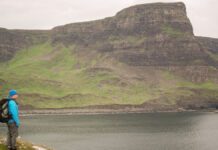
Dr Mike Morecroft, Climate Change expert at Natural England, has been looking at how we evaluate and measure success of climate change adaptation and mitigation in terrestrial ecosystems, and is the lead author on a recent review into the issue, published in the journal Science on 13 December. The full paper is available to view online here.
Key findings of the new scientific paper – a collaboration between Natural England, UK Centre for Ecology and Hydrology, British Trust for Ornithology, RSPB, Climate Resilience Ltd. and the University of Stellenbosch – include:
- Natural ecosystem restoration and other Nature-based Solutions must be at the forefront of efforts to mitigate and adapt to climate change.
- Although the success of efforts to reduce net greenhouse gas emissions can be measured by monitoring changing fluxes of greenhouse gases, adaption to climate change is more complicated to evaluate as it includes a wide variety of objectives and is about avoiding future harm.
- It is important to have a clear view of what constitutes success in climate change adaptation and mitigation and to be able measure progress.
- More emphasis on testing the effectiveness of proposed approaches to adaptation and mitigation is necessary for ongoing development of Nature-based Solutions.
- It is essential to take an integrated view of mitigation, adaptation, biodiversity, and the needs of people, to realize potential synergies and avoid conflict between different objectives.
Dr. Mike Morecroft, lead author of the study and Principal Specialist of Climate Change at Natural England said:
“Nature-based Solutions should be at the forefront of international efforts to tackle climate change. Natural forests, peatlands and other wild places need to be protected and restored to stop greenhouse gas emissions and take carbon dioxide out of the atmosphere.
“The great thing about Nature-based Solutions is that as well as reducing emissions, they also build the resilience of ecosystems, protect biodiversity and provide a wide range of benefits of people.
“It is important to do the right thing in the right place. For example restoring forests where they once grew is great, but planting trees, where there wouldn’t naturally have been trees, such as many of our upland bogs in the UK or in tropical savannas cab be very damaging and counterproductive.
“We need a clear understanding of what constitutes success when we manage the land to reduce greenhouse gas emissions or remove carbon dioxide from the atmosphere. This needs to take account of the need to also adapt to climate change that is already happening, protect biodiversity and meet the needs of people.”






